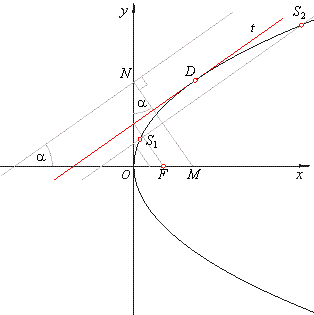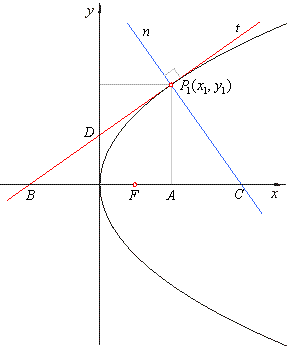|
| Conic
Sections |
|
|
|
Parabola
and Line
|
 Common points of a line and a parabola
Common points of a line and a parabola |
 Condition for a line to be the tangent to the parabola
- tangency condition
Condition for a line to be the tangent to the parabola
- tangency condition
|
 The equation of the tangent and the normal at the point on the parabola
The equation of the tangent and the normal at the point on the parabola
|
 Properties of the parabola
Properties of the parabola
|
|
|
|
|
|
|
| Common points of a line and a parabola |
Common points of a line and a parabola we determine by solving their equations as the system of two
equations in two unknowns, |
|
(1)
y = mx
+ c |
|
(2)
y2 =
2px
(1)
=> (2)
m2x2
+ 2(mc
-
p)x + c2
=
0, |
| therefore,
the coordinates of intersections of a line and a parabola |
 |
|
| Condition for a line to be the tangent to the parabola
- tangency condition
|
| In the formulas for calculating coordinates of intersections there is the expression under the square root
whose value determines three possible cases regarding mutual position of a line and a parabola, |
| so for
p >
0 and, |
|
p
-
2mc >
0
- the line intersects the parabola at two points S1(x1, y1) and S2(x2, y2), |
|
p
-
2mc
= 0 - the line is the
tangent of the parabola and have one point of contact D((p
-
mc)/m2,
p/m)) |
|
or by substituting p
= 2mc, the
tangency point D(c/m,
2c), |
|
p
-
2mc
< 0 - the
line and the parabola do not intersect. |
| If we write the above conditions as |
 |
then |
|
|
these
three cases can be explained graphically as
the relation between parameters
m
and c
of the line and the position of the focus F(p/2,
0).
|
|
At the y-intercept
N
of the line drawn is a
perpendicular which intersects the x-axis at
M,
then
|
|
ON
= | c | and OM
= | c · tan
a
|
= | m · c |.
|
|
Therefore, when the point
M
is located;
|
|
- to the left of
F, i.e.,
if m
· c
< p/2
|
|
the line intersects the parabola at
S1and S2,
|
|
- to the right
of F, i.e.,
if m
· c >
p/2
|
|
the line and the parabola do not intersect,
|
|
- at the focus F
or if m
· c
= p/2
|
|
the line is the tangent of the parabola.
|
|
 |
|
|
| The equation of the tangent and the normal at the point on the parabola
|
| In the equation of the line
y
-
y1
= m(
x
-
x1)
through the given point we express the slope m
by the given
|
| ordinate of the tangency point,
|
 |
|

|
|
and since the coordinate of the tangency point must
satisfy the equation of the parabola, then
|

|
| obtained
is |
y1y
= p(x
+ x1) |
the
equation of
|
|
|
the tangent at the point
P(x1, y1)
on the parabola.
|
| Since
|
 |
the above equation
|
|
|
can be written
using coordinates of the tangency point
|
|
|
|
 |
|
|
As the slope of the normal |
 |
then
the equation of the normal at P(x1, y1),
|
|
| |
 |
or |
 |
|
|
|
| Properties of the parabola
|
 Using equations of the tangent and normal expressed by coordinates of the tangency
point and
the figure above;
Using equations of the tangent and normal expressed by coordinates of the tangency
point and
the figure above;
|
|
a) y-intercept
ct
of the tangent equals half of the ordinates of the tangency point, ct
= y1/2. |
b) the projection
AB
of the segment BP1
of the tangent to the x-axis, i.e., to the axis of the parabola, is
equal to twice the abscissa of the tangency
point, so |
|
AB
= St
= 2x1 - the line segment
AB
is called the subtangent. |
|
c) the projection
AC
of the segment CP1
of the normal to the x-axis is equal to the parameter
p, i.e., |
|
AC
= Sn
= p - the line segment
AC
is called the subnormal. |
As points B
and C
are x-intercepts of the tangent and the normal their abscissas we determine by solving
corresponding equations for y =
0, so |
| put y =
0 into equation of the tangent, |
 |
|
| put
y =
0 into equation of the normal, |
 |
|
|
|
| Thus, the focus
F(p/2,
0) bisects the line segment
BC
whose endpoints are x-intercepts of the tangent and
the normal, as shows the figure above. |
|
 The tangent at any point on the parabola bisects the angle
j between focal distance and the perpendicular
to the directrix and is equally inclined to the focal distance and the axis of the parabola.
The tangent at any point on the parabola bisects the angle
j between focal distance and the perpendicular
to the directrix and is equally inclined to the focal distance and the axis of the parabola. |